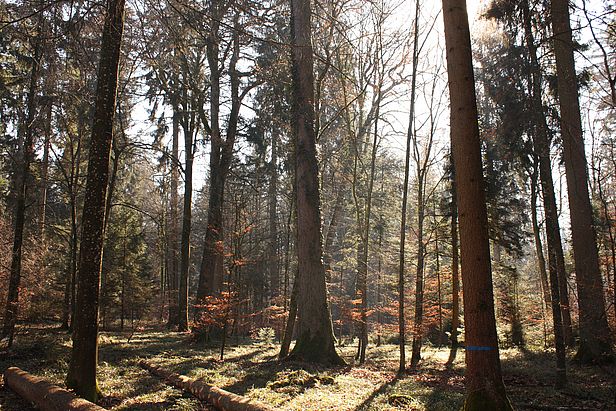Forest management using the group selection system
1997 - 2038
Project description ¶
Many mountain forests, such as Picea abies forests, are managed as relatively even-aged forests until they reach rotation age, and the process is repeated. They often have diameter and height distributions that approximate normal distributions. However, P. abies and many other species can also be managed in uneven-aged forests, such as selection systems. An extreme case is the single-tree or small group selection forest called a plenter forest, where the diameter distributions approximate a reverse-J-shape (Figure 1). While there is an abundance of data about the functioning of even-aged forests, there is far less information about plenter forests, especially about how to convert even-aged forests to plenter forests. This potentially inhibits the use of plenter forests or comparisons of their functioning with even-aged forests.
A major risk faced when converting even-aged forests to plenter forests is that the thinning can make the stand unstable in the face of disturbance events such as storms or avalanches. The thinning must begin early enough that there are still mature trees which are healthy enough to survive several decades until many new size classes have established and grown into the empty parts of the diameter and height distributions. However, the cohort of mature trees must also be thinned enough for the new cohorts to establish and develop without becoming suppressed.
The conversion typically begins with the creation of small gaps to encourage regeneration. Thinning is also done between the groups of regeneration to support future crop trees and thereby improve stand stability. The thinning is repeated approximately every 8 years and the stand is simultaneously measured. The conversion process alone often takes about 60 years or so, depending on the forest type and initial stand structure. The EFM network contains approximately 100 plots that are either plenter forest or in the process of being converted into plenter forests.
Potential collaborators are always welcome to use these plots to study other dynamics, such as browsing, regeneration, snow damage, forest avalanches, biodiversity etc.
Objectives: ¶
- Convert unthinned P. abies forests that were originally even-aged and even-structured, into plenter forests with stable reverse-J shaped diameter distributions (Figure 2). Details of this project can be found here (PDF1 & PDF2).
- Compare the growth dynamics of plenter forests to more even-structured forests with diameter and height distributions that approximate normal distributions.
- Quantify the effects of thinning on stand and tree growth while accounting for different sizes and dominance classes.
- Whenever possible, couple the plenter conversion plots with untreated plots or plots that are treated with the standard local “even-aged” thinning treatments.
- Compare the growth dynamics of different types of plenter forests, including:
- High altitude P. abies group-plenter forests. In these forests, the different size classes are mixed on a group-by-group basis, with groups of about 15-20 m in diameter (i.e. “Rottenstruktur” in German). The maintenance of group-by-group mixing for all size classes increases stability with regards to disturbances such as avalanches.
- Abies alba and Picea abies dominated forests (Figure 3).
- Fagus sylvatica dominated plenter forests (Figure 4). These also require a group-by-group mixing of different size classes, but for a different reason to the high altitude P. abies plenter forests. To develop a good stem form, Fagus sylvatica requires crown competition from neighbours with crowns at the same height. This prevents the excessive horizontal spread of the crowns.
- Variations on the above plenter forests, such as P. abies - F. sylvatica forests, A. alba - P. abies - F. sylvatica forests.
- Tree-species rich plenter forests (Figure 5).
- High-altitude Pinus cembra, Larix decidua and Picea abies plenter forests (Figure 6).

Figure 1. Example diameter distributions for a Picea abies – Abies alba plenter plot (1-031.000). The solid black line in the upper panel indicates the “equilibrium” state of the plot and shows a ln-transformation of the frequency on the y-axis. The middle panel indicates the species composition of the last measurement, with no ln-transformation of the y-axis. The lower panel shows the height distribution, which will have a reverse-J shape (as it does, roughly), if there is a vertical structure with trees of many heights within the canopy.

Figure 2. In contrast to the figures above, this figure shows a mountain Picea abies – Pinus cembra – Larix decidua forest that is in a stage of conversion towards a plenter structure (1-033.000). Note that there are still too many trees in the middle and upper diameter and height classes. However, this overabundance of large trees has been reduced with each thinning, as shown in the lower panel.




